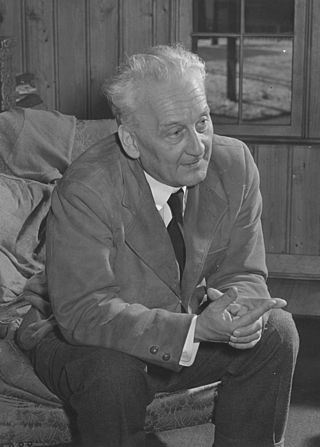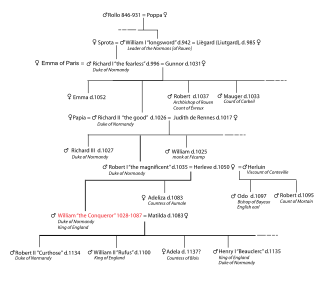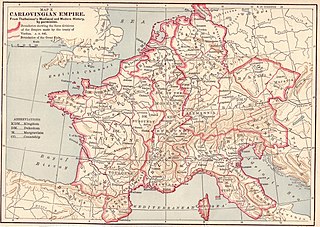Mastalus II (Italian : Mastalo) (died 958) was the first duke of Amalfi from 957 until his death.
He succeeded his father as patricius in 953, when he was still a minor. He came of age in 957 and was elected dux , raising him to equal rank with the Dukes of Gaeta and Naples. In the next year, he was assassinated by Sergius of Musco Comite family on the Monte di Scala.

The Doge of Venice, sometimes translated as Duke, was the chief magistrate and leader of the Republic of Venice between 726 and 1797.

Albert Imre Szent-Györgyi de Nagyrápolt was a Hungarian biochemist who won the Nobel Prize in Physiology or Medicine in 1937. He is credited with first isolating vitamin C and discovering the components and reactions of the citric acid cycle. He was also active in the Hungarian Resistance during World War II, and entered Hungarian politics after the war.

In the Middle Ages, the duke of Normandy was the ruler of the Duchy of Normandy in north-western France. The duchy arose out of a grant of land to the Viking leader Rollo by the French king Charles the Simple in 911. In 924 and again in 933, Normandy was expanded by royal grant. Rollo's male-line descendants continued to rule it until 1135. In 1202 the French king Philip II declared Normandy a forfeited fief and by 1204 his army had conquered it. It remained a French royal province thereafter, still called the Duchy of Normandy, but only occasionally granted to a duke of the royal house as an apanage.

Swietopelk II, also Zwantepolc II or Swantopolk II,, sometimes known as the Great, was the ruling Duke of Pomerelia-Gdańsk from 1215 until his death. He was the first member of the Samborides to style himself dux from 1227 onwards.
Frank William Dux is a Canadian-American martial artist and fight choreographer. According to Dux, a ninjutsu expert named Senzo Tanaka trained him as a ninja when he was a teenager. He established his own school of ninjutsu called Dux Ryu Ninjutsu, and has said he won a secret martial arts tournament called the Kumite in 1975. His alleged victory at the Kumite served as the inspiration for the 1988 film Bloodsport starring Jean-Claude Van Damme. Dux's victory at the Kumite has been disputed, as has the existence of both the Kumite he described and Senzo Tanaka.

Bloodsport is a 1988 American martial arts action film directed by Newt Arnold and starring Jean-Claude Van Damme, Leah Ayres, Forest Whitaker, Donald Gibb, Roy Chiao, and Bolo Yeung. The film centers on Frank Dux, a United States Army Captain and ninjitsu practitioner, who competes in an underground, full-contact martial arts tournament called the Kumite in Hong Kong. It was one of Van Damme's first starring films and showcased his athletic abilities, launching his career as a mainstream action star.
Richard, Duke of Burgundy (858–921), also known as Richard of Autun or Richard the Justiciar, was Count of Autun from 880 and the first Margrave and Duke of Burgundy. He eventually attained suzerainty over all the counties of Burgundy save Mâcon and by 890 he was referred to as dux (duke) and by 900 as marchio (margrave). By 918 he was being called dux Burgundionem or dux Burgundiae, which probably signified less the existence of a unified Burgundian dukedom than feudal suzerainty over a multiplicity of counties in a specific region.
The capital of Maine was Le Mans. In the thirteenth century it was annexed by France to the royal domain.

Dux is Latin for "leader" and later for duke and its variant forms. During the Roman Republic and for the first centuries of the Roman Empire, dux could refer to anyone who commanded troops, both Roman generals and foreign leaders, but was not a formal military rank.
The title Duke of the Franks has been used for three different offices, always with "duke" implying military command and "prince" implying something approaching sovereign or regalian rights. The term "Franks" may refer to an ethnic group or to the inhabitants of a territory called Francia.
Gisulf I was the eldest son of Guaimar II, Lombard Prince of Salerno, and his second wife Gaitelgrima. He was associated with his father as ruler in 943 and succeeded him on his death in 952. He took to using the title Langobardorum gentis princeps, "prince of the people of the Lombards". He was originally under the regency of his mother and Prisco (Priscus), treasurer and count of the palace.
Docibilis II was the ruler of Gaeta, in one capacity or another, from 906 until his death. He was the son of the hypatus John I, who made him co-ruler in 906 or thereabouts.
Landulf II, called the Red, was the Lombard prince of Benevento and prince of Capua from 939 or 940, when his father, Landulf I, first associated him with the government. His mother was Gemma, daughter of Athanasius of Naples. He may have been associated as early as 933, when his elder brother, Atenulf III, was made co-regent. His uncle Atenulf II died in 940 and it is likely that Landulf served as a replacement. Landulf married Yvantia on an unknown date.
Mastalus I was the penultimate patricius of Amalfi. He was succeeded by his son, Mastalus II, who was raised to the status of dux. His own father was the last prefect, Manso I.
Sergius I was the second Duke of Amalfi and first of the Musco Comite family.
Manso I or II was the Prefect of Amalfi from 898 to 914.

The March of Friuli was a Carolingian frontier march, established in 776 as the continuation of the Lombard Duchy of Friuli, established against the Slavs and Avars. It was ceded to the Duchy of Bavaria as the March of Verona in 952. Its territory comprised parts of modern-day Italy, Slovenia and Croatia.

The Diocese of Egypt was a diocese of the later Roman Empire, incorporating the provinces of Egypt and Cyrenaica. Its capital was at Alexandria, and its governor had the unique title of praefectus augustalis instead of the ordinary vicarius. The diocese was initially part of the Diocese of the East, but in ca. 380, it became a separate entity, which lasted until its territories were overrun by the Muslim conquest of Egypt in the 640s.
Fortún Galíndez was a powerful nobleman in the Kingdom of Navarre in the tenth century. He is the only recorded Navarrese of that time to bear the title dux (duke). He was entrusted by Sancho I with the newly conquered territory of the Rioja Alta around Nájera. In 924 he held the title senior in Naiera ; from 942 he was praefectus in Naiera ; and from 950 he was titled dux. He appears to have governed the Rioja with quasi-regal authority, part of a Navarrese experiment in creating a new kingdom, which would be the Kingdom of Viguera.

The Dux de Lux, originally called Llanmaes, was a popular beer garden and restaurant in Christchurch, New Zealand, that was part of the Arts Centre.